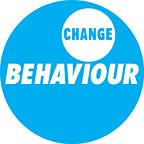Return to the bike: a journey in behavioural science
There is a lover of cycling who, as hard as they try, cannot commit to the bike. Though they enjoy the ride, the lowered carbon emissions, whizzing around the city, exploring places unknown — the act of getting on the bike is, well, challenging. The weather is often uninviting, tiredness lingers from that late night on the weekend, the dreaded helmet hair looms, and so, inevitably, the ease of the underground calls (despite the destined armpits in the face scenario).
I have to confess, this is my story. Due to life’s noises, I became so infrequent with cycling that the local spider community weaved home upon home between my spokes, and mounds of leaves accumulated around my sedentary wheels. I found myself in a dilemma, but working at Behaviour Change got me thinking about how I can regain control of my cycling behaviour.
I managed to change my cycling behaviour and get back on the saddle *almost* daily by using the tools of behavioural science. If you would like to know how, read on and join my journey of change and overcoming the noise.
Making it timely:
Behavioural science tells us that motivation often fluctuates and this is true in my case. Leaving my bike ‘out of sight, out of mind’ allowed me to almost forget I even had a bike in the first place and absent-mindedly skip along to the train station. To combat this, I implemented a behavioural nudge by placing my bike where I could see it. This visual cue served as my new default, an everyday reminder of my cycling intent, prompting me to choose cycling over the dreaded rush hour tube.
Making the journey attractive:
Cycling alongside cars, buses and mopeds is loud, bad for your lungs and, let’s face it, scary! To conquer my cycling journey I opted for a different route, the back route, where cycling alongside these gas-guzzling metal machines was significantly reduced. The lycra brigade, however, remains a force to be reckoned with.
Reframing:
For those of us who live in the UK, we are too aware of the weather and it is often far from idyllic. Rain and wind are huge barriers to cycling, at least in my case, so I knew something had to change.
I reframed the “bad” weather. Instead of viewing rainy days as treacherous obstacles, I framed them as opportunities to see London in a different light, a means of cooling down after cycling up the dreaded hill that is Waterloo Bridge, to strengthen my resolve and resilience.
This shift in mindset made typically inconvenient conditions more manageable. And if I get a bit wet on the way to work, so what? I can just change into dry clothes when I arrive at the office.
I must add a caveat here: all the framing in the world can’t resolve, say, the Beast from the East, so in those cases, I am absolutely not cycling and neither should you.
Adding pressure:
I told everyone who would listen that I was going to cycle to work every day, despite life’s barriers. Behavioural science emphasises the importance of using social pressure as a tool or strategy that makes it harder to deviate from your goals. Safe with the knowledge that everyone knew about my commitment, I plotted that this pressure would encourage me to stick to the bike.
Incentivisation:
Incentives are commonly used as a way to make lifestyle changes like, for example, getting a takeaway after a week of healthy eating. Every now and then I treat myself to a nice breakfast or coffee from the local cafe.
Most notably, I added my daily train fare savings into a pot on my banking app. £8 a day on transport really adds up, so after a while, I was able to book a trip to Ghent via the Eurostar with my accumulated ‘didn’t get the train’ money. Now that’s what I call an incentive!
In the end, my journey of returning to the bike has certainly been a ride, complete with thrilling highs and challenging lows. But I’m back on the open road, and loving the freedom, the money saved, and the adventure that cycling brings to my life (without sounding like I’m going to break into song).
In true ‘new year, new me’ style, if there’s something you’d like to change in your life, consider giving behavioural science tools a try and see what positive changes you can make to conquer 2024.
